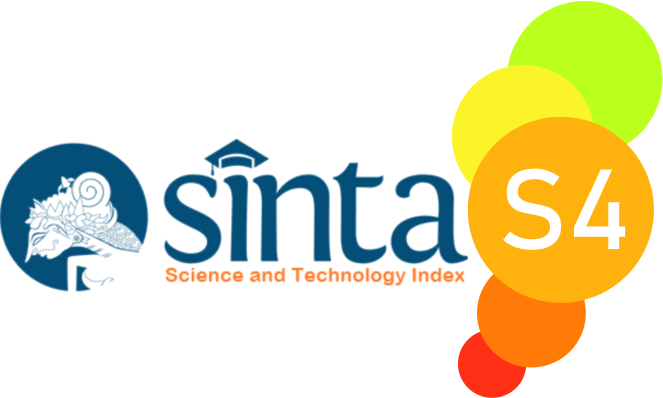AN ANALYSIS OF COGNITIVE LINGUISTICS TENETS IN AN ENGLISH FOR SPECIFIC PURPOSES TEXTBOOK
Abstract
In English language teaching, cognitive linguistics has played an important role in classroom activities. This can be the depicted in the use of the textbooks. In this study, the textbook used is English for international Relations book, a part of English for Specific Purposes series published by Universitas Muhammadiyah Malang. Two of the features that chime cognitive linguistics principles are metaphors and categorization leading to prototype. Meanwhile, one of the clashes that is apparent in the textbook is the use of English which is unnatural, one of the factors is the textbook is used in a non-English speaking country. In the end, there are some suggestions on how to deal with the tenets of cognitive linguistics for the features that still clash with the principles of cognitive linguistics. First, it can be done by introducing some words that may have different meanings if they are added with different prepositions. The second example might be adjusting the use of the pictures and illustrations with the text and context. Also, the learners are suggested to know the patterns of the target language as they are different from their mother tongue.
References
About Cognitive linguistics - Cognitive Linguistics. (n.d.). Retrieved May 8, 2016, from http://www.cognitivelinguistics.org/en/about-cognitive-linguistics
Boers, F. & Lindstromberg, S. (2009). Optimizing a lexical approach to instructed second language acquisition. New York: Palgrave Macmillan.
Boers, F. (n.d.). Week 2: Cognitive Linguistics and the Notion of Linguistic Motivation (The Non-arbitrary Nature of Language [PPT doc]. Retrieved from Victoria University of Wellington Blackboard site.
Celce-Murcia, M., Brinton, D., & Snow, M. A. (2014). Teaching English as a second or foreign language (Ed.) (4th ed.). Boston: National Geographic Learning.
Croft, W., & Cruse, D. A. (2004). Cognitive linguistics. Cambridge University Press.
Features of Textbooks | eHow. (n.d.). Retrieved May 8, 2016, from http://www.ehow.com/info_8455169_features-textbooks.html
Graduate Institute of Linguistics Fu-Jen University. (2005). Lecture 1: Introduction to Cognitive Linguistics [PPT doc]. Retrieved from http://www.ling.fju.edu.tw
Guiding Principles for Quality Textbooks (2014). (n.d.). Retrieved May 8, 2016, from http://www.edb.gov.hk/en/curriculum-development/resource-support/textbook info/GuidingPrinciples/index.html
Hall, G. (2011). Exploring English language teaching: language in action (1st ed.). New York: Routledge.
Harmer, J. (2015). The practice of English language teaching. (5th ed.). Harlow: Pearson Education Limited.
Harwood, N. (2014). English language teaching textbooks: content, consumption, production (Ed.). Basingstoke: Palgrave Macmillan.
Jarum, Lestiono, R., Wahyuningtyas, D., Moertopo, A., Wulandari, R. M., & Zulferdi, L. A. (2015). English for international relations. Malang: UMM Press.
Lalonde, C. (2014, March 27). The pedagogical features of a textbook. Retrieved May 8, 2016, from http://clintlalonde.net/2014/03/27/the-pedagogical-features-of-a-textbook/
Littlemore, J. (2009). Applying cognitive linguistics to second language learning and teaching. New York: Palgrave Macmillan.
Masuda, K., Arnett, C., & Labarca, A. (2015). Cognitive linguistics and sociocultural theory: applications for second and foreign language teaching. Walter de Gruyter GmbH & Co KG.
Stambuk, A. (1998). Tenets of Cognitive Linguistics as a Framework for Terminology Research. Papers and Studies in Constrative Linguistics, 34, pp. 233-243. School of English, Adam Mickiewicz University, Poznan, Polandia. Retrieved from http://ifa.amu.edu.pl
Susanto, H. (2021). An Analysis about Students’ Troubles in Acquisition English Vocabulary. Journey: Journal of English Language and Pedagogy, 4 (2), 46-50.
Tyler, A., Mueller, C. M., & Ho, V. (2010). Applying Cognitive Linguistics to Instructed L2 Learning: The English Modals. AILA Review, 23(1), 30–49. http://doi.org/10.1075/aila.23.03tyl
Verspoor, M., & Boers, F. (2013). Cognitive Linguistics of Second Language Acquisition. The Encyclopedia of Applied Linguistics, Edited by Carol A. Chapelle. Blackwell Publishing Ltd.
doi: 10.1002/9781405198431.wbeal0148
Copyright (c) 2022 Dwi - Wahyuningtyas

This work is licensed under a Creative Commons Attribution-ShareAlike 4.0 International License.

Journey: Journal of English Language and Pedagogy by http://ejurnal.budiutomomalang.ac.id/index.php/journey/index is licensed under a Creative Commons Attribution-ShareAlike 4.0 International License.






